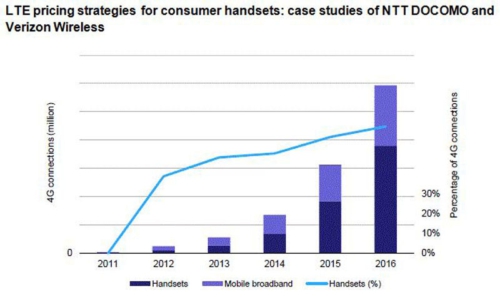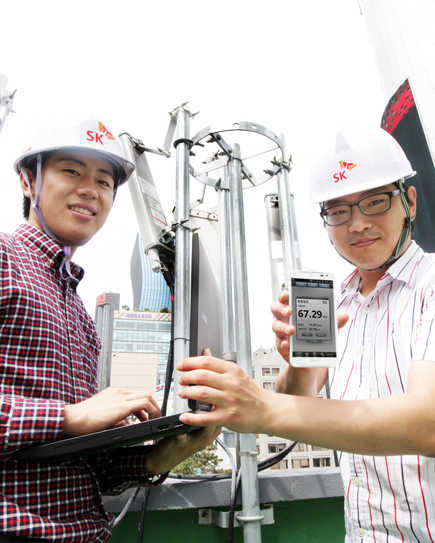Commercial roll-outs of the VoLTE service will begin in early Oct across the nation.
So far, LTE, or long term evolution mobile network service had been available only for data transfer on the commercial LTE networks of the country’s three mobile service carriers.
KT’s competitors -SK Telecom and LG U+- plan to roll out their respective VoLTE services sometime in the second half of this year, too
The commercial roll-out of VoLTE service will allow mobile phone users to enjoy crisper and noise-free voice as well as crystal-clearer video calling services. It also represents KT’s catch-up drive to snatch back growth dynamics lost to two front-runners –SK Telecom and LG U+-in domestic LTE market.
LTE network can carry voice and data communications three times faster than incumbent 3G technology.
The broadband speed of the LTE network not only promises to open up new market opportunities, but also to create new streams of revenue, because it enables service carriers to offer a wealth of more lucrative value-added data-voice combo services like full HD mobile broadcasting, or mobile VOD services.

To gain an early lead in the more profitable and fast-growing VoLTE service market, the three mobile service carriers are not only expanding their LTE network coverage, but also upgrading them,
At the center of their competition is to how to better serve prospective subscribers by offering user-friendlier and speedier network access as well as faster handover services between different network technologies.
Following the country’s largest mobile operator SK Telecom’s lead in the introduction of multi-carrier LTE service, for example, KT unveiled a single unified LTE network service platform called as “LTE WARP advanced”.
The platform supports a variety of novel and innovative technologies like a multi-carrier LTE service, a carrier aggregation technology, a quad-antenna technology, an always best connected roaming service, and a micro femto-cell service.
The multi-carrier LTE service, which will be commercially available starting in August, is a hybrid network technology that uses two different radio spectrums to allocate mobile phone users on demand for network accesses to the less traffic-loaded network of the twos to avoid traffic overload
KT will use 900 MHz frequency band and 1.8GHz spectrum to offer the multi-carrier service. KT‘s commercial multi-carrier service will be available only in capital Seoul and its suburbs for a while until it will expand its coverage across the country.

Its backyard archrival SK Telecom already started the multi-carrier service using its existing 800MHz frequency band and new 1.8GHz spectrum in July 1, giving a total of 40MHz bandwidth for LTE service in what the carrier said is the fastest and most reliable LTE service.
SK is also expanding its multi-carrier LTE service beyond its first serviceable affluent Gangnam area in Seoul into major areas in other metropolitan cities by year-end.
To fight back SK’s lead, KT plans to add more features to its multi-carrier service.
Starting with September, KT is scheduled to offer a handover roaming service among Wi-Fi, 3G and LTE networks in what the carrier dubs as ‘Always Best Connected’, or ABC service, a traffic guidance technology that steers incoming calls to the most optimal network among the three networks.
That handover service allows mobile phone users to freely roam among Wi-Fi and LTE/3G network either to download, or upload data-heavy contents without suffering interruption in handing over to the most optimal network.
KT’s innovation doesn't stop there. Beginning with the 3rd quarter of 2013, KT plans to offer a carrier aggregation commercial service, a technology that combines the two frequency bandwidths of the multi-carrier network into one virtual network as if they were one network. The carrier aggregation technology will offer a network access speed of 150Mbps, double than in real mode, according to KT.
The commercialization of its quad-antenna technology, which is scheduled for the 4th quarter of 2012, will play a part in the efficient and effective use of its LTE network, helping to improve the network capacity by 80%.
According to some estimates, SK Telecom has signed up about 3.8 million LTE subscribers, so far, while LG U+ has about 2.8 million LTE subscribers. Meanwhile, KT has about 1.40 million subscribers, as the carrier was far behind in the adoption of LTE technology. Collectively, the country has signed up more than 8 million LTE subscribers, so far to become one of the fastest-growing LTE market.
SK Telecom expects it LTE subscribers to hit about 7 million by year-end, while KT targets to sign up about 4 million LTE subscribers in total until the end of this year.

Affordable tiered flat rate LTE pricing policies will be another allure. While offering new tiered monthly flat rate LTE pricing options depending on total usage minutes of voice and data, KT newly introduced a data rollover pricing scheme, which allows mobile phone users to put their unused minutes of data for a month to reuse for next month.
LTE network service is now rapidly spreading across the word, as mobile service carriers in Asai and the U.S. are offering tiered pricing models that combine 3G and 4G technology across all tiers.
Verizon Wireless, AT&T and Sprint are now racing to deploy their respective LTE network in the U.S. In Japan, NTT DOCOMO is leading the penetration.
In Europe, mobile operators in France, Germany and Italy are using a 800 MHz spectrum to offer their LTE service, while others in Denmark are riding on a 2.6GHz spectrum.
And, Korean operators are the most aggressive and fastest in the world in adopting VoLTE services, living up to their reputation as a global test bed for IT technologies.

